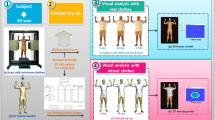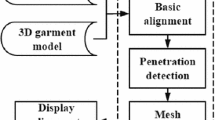Abstract
According to the anisotropic property in most real-world cloth for virtual fitting, this paper proposes a novel dynamic cloth simulation method via geometric deformation energy model that preserves geometric features well to achieve cloth behaviors with various material effects. We first construct an objective deformation energy with the terms including vertex position, edge length, dihedral angle, and gravitation, then we conduct a numerical solution in the least square sense. In order to establish the dynamic cloth deformation solution, we further analyze the corresponding relationship between different weights in front of geometric energy terms and material properties by comparison with the real photographs of typical real fabrics. Establishing a dynamic weight-regulation measure can model similar cloth anisotropic behaviors for virtual fitting applications in digital home. The experiments show that our approach effectively provide more rich cloth deformation results with distinctive material effects.













Similar content being viewed by others
References
3D, C (2011) CLO Virtual Fashion Inc. http://www.clo3d.com/
Alexa M (2003) Differential coordinates for local mesh morphing and deformation. Vis Comput 19(2):105–114
Baraff D, Witkin A (1998) Large steps in cloth simulation. In: SIGGRAPH ’98 proceedings of the 25th annual conference on computer graphics and interactive techniques, pp 43–54
Breen D, House D, Wozny M (1994) A particle-based model for simulating the draping behavior of woven cloth. Tex Res J 64(11):663–685
Bridson R, Fedkiw R, Anderson J (2003) Simulation of clothing with folds and wrinkles. In: SCA ’03 proceedings of the 2003 ACM SIGGRAPH/Eurographics symposium on computer animation, pp 28–36
Chen M, Tang K (2010) A fully geometric approach for developable cloth deformation simulation. Vis Comput 36(6):853–863
De Aguiar E, Sigal L, Treuille A, Hodgins J (2010) Stable spaces for real-time clothing. ACM Trans Graph (TOG) 29(4):106:1–9
Decaudin P, Julius D, Wither J, Boissieux L, Sheffer A, Cani M (2006) Virtual garments: a fully geometric approach for clothing design. Comput Graph Forum 25(3):625–634
Goldenthal R, Harmon D, Fattal R, Bercovier M, Grinspun E (2009) Efficient simulation of inextensible cloth. In: ACM Transactions on Graphics (TOG)-proceedings of ACM SIGGRAPH 2007, pp 557–564
Graphite (2010) ALICE geometry and lighting, vol 2. http://alice.loria.fr/index.php/software.html.
Hadap S, Bongarter E, Volino P, Magnenat-Thalmann N (1999) Animating wrinkles on clothes. In: Visualization ’99. Proceedings, pp 175–523
Hinds B, McCartney J (1990) Interactive garment design. Vis Comput 6(2):53–61
Huang J, Shi X, Liu X, Zhou K, Wei L, Teng S, Bao H, Guo B, Shum H (2006) Subspace gradient domain mesh deformation. In: ACM Transactions on Graphics (TOG)-proceedings of ACM SIGGRAPH 2006, vol 25, pp 1126–1134
Huang J, Zhang H, Shi X, Liu X, Bao H (2006) Interactive mesh deformation with pseudo material effects. Comput Anim Virtual Worlds 17(3–4):383–392
Ju T, Schaefer S, Warren J (2005) Mean value coordinates for closed triangular meshes. In: ACM Transactions on Graphics (TOG)-proceedings of ACM SIGGRAPH 2005 vol 24(3), pp 561–566
Julius D, Kraevoy V, Sheffer A (2005) D-charts: quasi-developable mesh segmentation. Comput Graph Forum 24(3):581–590
Kang M, Lee J (2007) A real-time cloth draping simulation algorithm using conjugate harmonic functions. Comput Graph 31(2):271–279
Lewis J, Cordner M, Fong N (2000) Pose space deformation: a unified approach to shape interpolation and skeleton-driven deformation. In: Proceedings of the 27th annual conference on computer graphics and interactive techniques, pp 165–172
Lipman Y, Sorkine O, Cohen-Or D, Levin D, Rossi C, Seidel H (2004) Differential coordinates for interactive mesh editing. In: Shape modeling applications, 2004 Proceedings, pp 181–190
Liu Y, Pottmann H, Wallner J, Yang Y, Wang W (2006) Geometric modeling with conical meshes and developable surfaces. ACM Trans Graph (TOG) 25(3):681–689
Magnenat-Thalmann N (2010) Modeling and simulating bodies and garments. Springer, Ltd
MayaCloth (2010) http://caad.arch.ethz.ch/info/maya/MayaCloth. Autodesk
Müller M, Chentanez N (2010) Wrinkle meshes. In: Proceedings of the 2010 ACM SIGGRAPH/Eurographics symposium on computer animation, pp 85–92
Popa T, Julius D, Sheffer A (2006) Material-aware mesh deformations. In: Shape modeling and applications, pp 1–12
Popa T, Zhou Q, Bradley D, Kraevoy V, Fu H, Sheffer A, Heidrich W (2009) Wrinkling captured garments using space-time data-driven deformation. Comput Graph Forum 28(2):427–435
Provot X (1995) Deformation constraints in a mass-spring model to describe rigid cloth behaviour. In: Graphics interface, pp 147–157
Sederberg T, Parry S (1986) Free-form deformation of solid geometric models. ACM Siggraph Comput Graphics 20(4):151–160
Sorkine O, Alexa M (2007) As-rigid-as-possible surface modeling. In: SGP ’07 proceedings of the fifth Eurographics symposium on geometry, pp 109–116
Sorkine O, Cohen-Or D, Lipman Y, Alexa M, Rossl C, Seidel H (2004) Laplacian surface editing. In: Proceedings of the 2004 Eurographics/ACM SIGGRAPH symposium on geometry processing, pp 175–184
Tang K, Chen M (2009) Quasi-developable mesh surface interpolation via mesh deformation. IEEE Trans Vis Comput Graph 15(3):518–528
Thomaszewski B, Pabst S (2009) Continuum-based strain limiting. Comput Graph Forum 28(2):569–576
Wang H, Hecht F, Ramamoorthi R, O’Brien J (2010) Example-based wrinkle synthesis for clothing animation. ACM Trans Graph (TOG) 29(4):107:1–8
Weil J (1986) The synthesis of cloth objects. In: SIGGRAPH ’86 proceedings of the 13th annual conference on computer graphics and interactive techniques, vol 20, pp 49–54
Xu W, Zhou K, Yu Y, Tan Q, Peng Q, Guo B (2007) Gradient domain editing of deforming mesh sequences. ACM Trans Graph (TOG) 26(3):84:1–10
Yu Y, Zhou K, Xu D, Shi X, Bao H, Guo B, Shum H (2004) Mesh editing with poisson-based gradient field manipulation. In: ACM Transactions on Graphics (TOG)-proceedings of ACM SIGGRAPH 2004, vol 23, pp 644–651
Acknowledgements
This research is supported by the National Natural Science Foundation of China (61073131, 61272192, 61100080), NSFC-Guangdong Joint Fund (No. U1135003, U0935004), the National Key Technology R&D Program (No. 2011BAH27B01, 2011BHA16B08), the Industryacademy- research Project of Guangdong (No. 2011A091000032), Scholarship Award for Excellent Doctoral Student Granted by Ministry of Education 2012.
Author information
Authors and Affiliations
Corresponding author
Rights and permissions
About this article
Cite this article
Liu, L., Wang, R., Su, Z. et al. Mesh-based anisotropic cloth deformation for virtual fitting. Multimed Tools Appl 71, 411–433 (2014). https://doi.org/10.1007/s11042-013-1437-5
Published:
Issue Date:
DOI: https://doi.org/10.1007/s11042-013-1437-5




